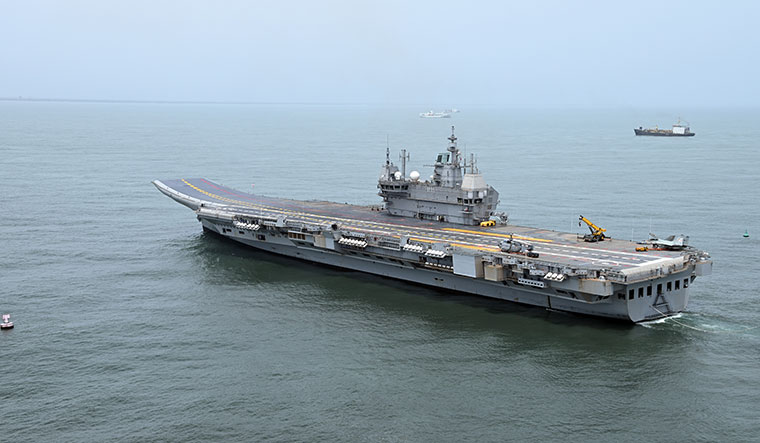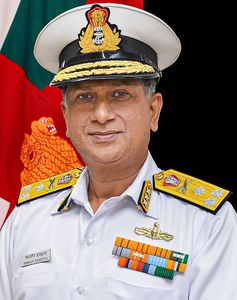India is a maritime nation’ is an oft-heard phrase, strategically inserted into speeches of senior politicians and government functionaries. It has a nice ring to it. People believe what they say because of the exalted stature of the speakers. Besides, it sounds quite self-glorifying. This belief, however, is not necessarily because we understand what it means to be a maritime nation.
Geographically, India is a maritime nation. There was never a doubt about it. Very few countries in the world have oceans on three sides. No other country in the world has an ocean named after it. India’s maritime and seafaring tradition dates back to 3,000 BCE when the Indus Valley civilisation was known to have maritime trade with Mesopotamia.
Geography has time and again shaped the history of nations. Rivers and seas have been critical elements of such civilisational histories, be it the early Egyptian civilisation along the banks of the Nile or our very own Indus Valley. Two-thirds of civilisations live within 200 miles from coasts. It is also an undeniable fact of history that invaders who came to India across the land borders either went back or were assimilated, but the colonisers who came to India from the sea enslaved, plundered and looted the Indian people for over three centuries.
Does India possess a maritime mindset? The answer is a big ‘no.’ It was a bigger ‘no’ till even a few years ago. It has been a recent realisation that India has to look towards the sea not just to counter maritime adversaries, but also for its economic well-being. This is what we term as the ‘Blue Economy’. We are ‘Blue’ in word, but not in thought and deed. Here is why.
DEFENCE
Economy and defence are inextricably linked. Without one being robust, the other will also have shortfalls. However, if the security umbrella is weak, no aspect of economic well-being will enjoy immunity from external intervention. The naval expansion of China and the modernisation of the Pakistan navy―despite its struggling economy―offer warning signs to India about the nexus between the two, as all of Pakistan’s modernisation is from Chinese sources.
We are aware that the ingress of Chinese naval forces into the Indian Ocean has to be from our east. Common sense tells us that our eastern gatekeeper must be strong. Sadly, we have not developed the Andaman and Nicobar Islands to be our strong eastern gatekeeper, as was envisaged when the tri-service Andaman and Nicobar Command (ANC) was established in 2001. For the Indian armed forces, the Andaman and Nicobar Islands should become the equivalent of what Hawaii is for the US military before time runs out. Our thrust towards theaterisation provides us one last chance. The ANC must be the bulwark of the Maritime Theatre Command against any misadventure from the east.
Force structures and planning must give us the deterrence to prevent war and promote peace. A multidimensional adversary requires a multidimensional force to thwart any design detrimental to our interests. So, debates about whether we must have aircraft carriers or nuclear-powered submarines or long-range reconnaissance is of little use. Each has its critical utility and all of them are required for the defence of our maritime interests.
COASTAL SECURITY
India recognised the need for a specialised coastal force in the late 1970s and the Coast Guard was constituted in 1980 by an act of Parliament. Since then, the Coast Guard has grown in size and strength to one of the largest coastal constabulary forces in the world with potent surface and air assets. Several other agencies also have responsibilities with regard to coastal security; such as the customs, immigration, revenue intelligence, port authorities, oil and gas operators and state police forces. Coordination among these agencies is an involved task and often difficult since each has its own priorities, reporting authorities and organisational peculiarities.
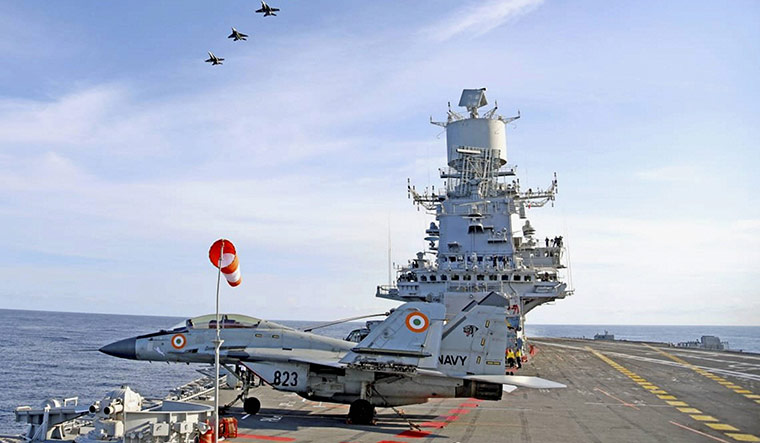 Sky is the limit: MiG 29ks from INS Vikramaditya in action during Malabar Exercise 2020 in which Australia, Japan and the US also participated | PTI
Sky is the limit: MiG 29ks from INS Vikramaditya in action during Malabar Exercise 2020 in which Australia, Japan and the US also participated | PTI
The terrorist attacks in Mumbai on November 26, 2008 (the 26/11 attacks) with miscreants infiltrating through the sea route and landing at a crowded fishing village in the heart of Mumbai exposed gaping holes in our maritime intelligence and security apparatus. In its aftermath, the government put several mechanisms into place including the formation of state marine police, carved out of the regular police forces, and the creation of coastal police stations. A comprehensive coastal security scheme was put in place and executed in phases, which, among other things, included funding and provision of patrol boats for marine police forces of coastal states. The Indian Navy was made responsible for overall maritime security with the naval commanders-in-chief being additionally designated as commanders-in-chief coastal defence. The Coast Guard director general was designated as commander, coastal security, with Coast Guard as the lead intelligence agency for this purpose.
Apex and state-level monitoring committees were set up and several policy directives were issued to streamline coastal security mechanisms. In 2022, the government appointed a retired Navy vice chief as the National Maritime Security Coordinator (NMSC) to ensure robust apex-level policymaking and monitoring. Subsequently, each coastal state was directed to appoint state maritime security coordinators to be the single-point contact for coastal security. Despite such measures, implementation on ground has been tardy, and turf wars continue because of organisational inadequacies, lack of sea-going expertise and technical maintenance among police personnel, slow implementation of the coastal security scheme and other reasons. Even today, police personnel assigned to state marine police are considered to be ‘sidelined’. As a result, chinks remain in our coastal security armour.
SHIPBUILDING AND REPAIR
Ninety per cent of the global trade is carried over the oceans. This percentage is unlikely to come down in the future since ships are the only means of transporting bulk cargo, fuel, dangerous chemicals, gases and all other commodities. Shipbuilding is, therefore, one industry that will continue to flourish now and in the future. The range of ships that are used varies from small coastal cargo ships to three-million-tonne crude carriers with every description of ships in between. Additionally, there are specialised ships that are needed for navies, oil industry, hydrographic and oceanographic research, satellite tracking, island support, cruise and passenger vessels.
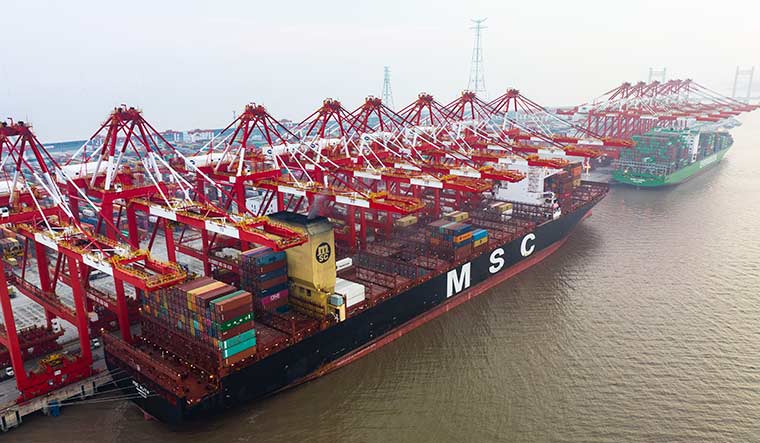 Moving the world: A super large container ship lifts containers in Shanghai, China | Getty Images
Moving the world: A super large container ship lifts containers in Shanghai, China | Getty Images
It does not take any specialised knowledge to understand that shipbuilding and ship-repair businesses can be long-term money spinners if they can cater to domestic and export markets. It, however, does take a maritime mindset to realise the benefits and facilitate this industry. Another significant statistic is that China and South Korea share close to 90 per cent of the shipbuilding market between them, with China’s share being about 47 per cent. India, in comparison, is not even on the shipbuilding and ship-repair map of the world.
India has the potential to make quality ships for domestic industry and for export, but the industry environment does not facilitate quality, price and competitiveness. Overheads are high, shipyards are inefficient, labour laws favour inefficiency, and dependence on imports is high. Even public sector defence shipyards are kept afloat by the requirements of the Indian Navy that compulsorily require warships to be built in India. Conditions have to be created that make Indian shipbuilding and ship-repair industries much more efficient and competitive.
MERCHANT MARINE
Nearly 90 per cent of India’s trade by volume and 70 per cent by value moves over the sea. India is now among the five largest economies of the world and growing. However, India’s share in the global trade remains below 2 per cent compared with China’s 14 per cent. Perhaps then not surprisingly, India’s share of global shipping tonnage also stands at 1.3 per cent while China is at 13.7 per cent. As the country grows economically and the share of global trade increases, it will have to be matched by a growth in Indian-owned ships as well.
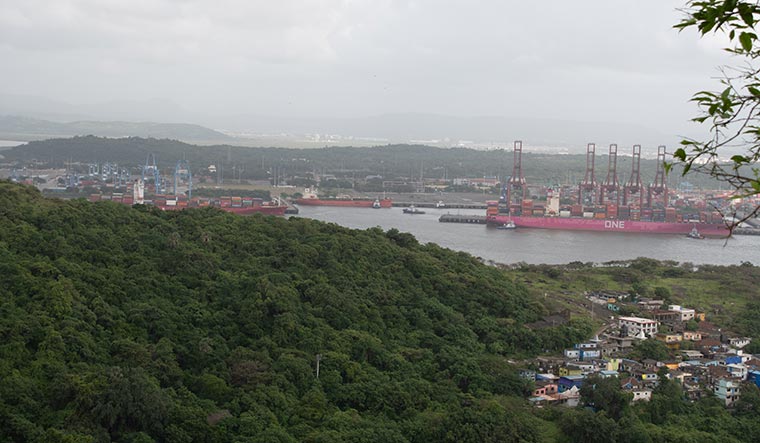 The JNPT port in Navi Mumbai | Shutterstock
The JNPT port in Navi Mumbai | Shutterstock
There is also the vulnerability angle in times of conflict when assured supplies of critical commodities may become important in the absence of sufficient reserves. International shipping operators become reluctant to operate in conflict zones because of the threat of collateral damage in addition to high insurance costs that come into play. The shipping tonnage available with national carriers has to be maintained at a minimum level to ensure the flow of essential commodities at all times. There are major shortfalls in this respect.
Coastal passenger traffic and inland water transportation are other areas that require working to a time-bound plan as these have tremendous potential in many of our coastal states. Kerala and West Bengal are prime examples of states where a thriving inland water system existed earlier but fell into neglect and disuse. Such transport not only is cheap and clean, but also adds to the economy in terms of employment and revenue generation through commercial passenger traffic and tourism.
PORTS AND MARITIME INFRASTRUCTURE
India ranks 18th in the world in terms of length of coastline (17,200km) and 13th in the number of major ports (13). While appearing quite linear in this sense, such a simplistic comparison may be misleading. Development of ports and maritime infrastructure should aim to meet our sea transport needs and boost our economy by providing services, creating employment for locals, utilising domestic products and conducting efficient and profitable port operations. They should be part of an ecosystem that also energises the shipbuilding and ship-repair industry.
 Prize catch: Fishing boats at Balaramgadi in Odisha | Salil Bera
Prize catch: Fishing boats at Balaramgadi in Odisha | Salil Bera
Efficiency of port operations is a function of several factors. These range from good port facilities, use of modern technology, efficient human resource, round-the-clock operations, good road networks leading to the port, robust security mechanisms and world-class services. Compare the most efficient port in the world, Shanghai, and the most efficient port in India, JNPT (Navi Mumbai): the former handles 47.3 million TEU (twenty-foot equivalent units) and the latter, 6.05 million TEU as per latest figures. Operation of ports and similar authorities are professional tasks and the management must be selected with care. Generalists from administrative and police services are routinely appointed to head such organisations where better choices would be people with maritime backgrounds.
While major ports would continue to be the hubs of our maritime economy, this would have to be augmented by non-major ports that could serve coastal trade and small-ship traffic. Strategically located transshipment hubs should be built to cater to cargo management of international traffic. Colombo’s strategic location as a transshipment hub was a lesson for India. Vizhinjam Mega Transshipment Hub in Kerala, being created as an alternate transshipment hub to Colombo Port and scheduled for completion in 2024, is a good move. Developing the Great Nicobar Port at Galathea Bay in the Andaman and Nicobar Islands is yet another significant move, but the plan for commencing construction in 2028 and completing it in phases by 2058 needs review. India cannot take 30 years to build a transshipment port.
FISHING
India is the third largest fish-producing country in the world. This can broadly be divided into inland fishing, including aquaculture, and marine fishing. Of the total fish production of 17.4 million tonnes in 2022-23, just about one-fourth is attributed to marine fishing. This is gross under-exploitation of the over 2.2 million square kilometres of exclusive economic zone (EEZ). Most of our marine fisherfolk belong to small fishing hamlets along our coast and are small-time operators. The country lacks a deep-sea fishing ecosystem while China and Taiwan have long-endurance, refrigerated, mini-factory ships that not just harvest fish, but also process and refrigerate them for long shelf-lives and transfer the produce to other vessels at sea.
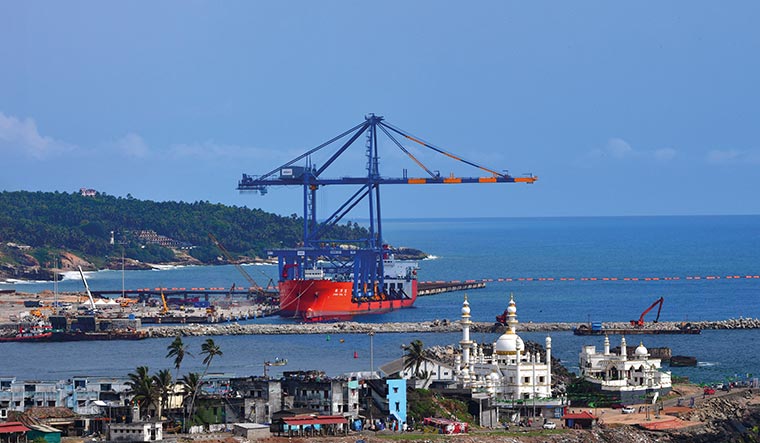 New horizons: Inaugural vessel docking at the Vizhinjam International Port | J. Suresh
New horizons: Inaugural vessel docking at the Vizhinjam International Port | J. Suresh
Because of this lack of capability, there is a standing joke that ‘in the Indian EEZ, fish die of old age’. Large-scale deep-sea fishing requires an enabling ecosystem. Business houses with more financial muscle need to invest in it. Skilling of crew in sea-going, fishing and various other activities as also developing a profitable market would all be necessary. Such an environment would require robust government policy and financial support. In the absence of such a deep-sea fishing capability with India and its smaller maritime neighbours, Chinese trawlers and fishing vessels engage in widespread illegal fishing in the Indian Ocean Region, especially in EEZs of countries that do not have the wherewithal to monitor illegal fishing. These vessels often venture into the Indian EEZ as well. The possible use of these vessels for intelligence gathering, grey-zone activities and other non-commercial purposes is a security threat.
POLLUTION REVERSAL
Another serious challenge is that of pollution. The oceans and rivers have got polluted. Coastal ocean areas are seriously affected by industrial effluents and untreated waste coming from inshore. Ports and harbours suffer heavily from plastic and oil pollution created by surrounding habitats and visiting ships. Marine pollution caused by accidents at sea affects ocean flora and fauna adversely and also wash ashore, affecting the coastal population.
Pollution response or pollution control is not enough anymore. The need of the hour is pollution reversal, whatever it takes. Shutting down polluting industries, stopping depletion of mangroves and marshes in the name of SEZs, taking strong action against disposal of untreated sewage, imposing hefty fines or cancelling of licences, finding and enforcing alternatives to plastic and controlling indiscipline by citizens are some measures that can be taken immediately. Strong and standard protocols need to be applied across all coastal states that act as deterrents. All agencies responsible for preventing pollution and those polluting must be held to account and pollution control wherewithal strengthened. There is no more time to lose.
THE UNDERWATER DOMAIN
The underwater domain is deep, dark and mysterious. It is almost impervious to visual, radio and radar spectrums. Technologies have enabled human existence in submarines and submersibles up to limited depths. The only waves that travel through the ocean waters are in the sonic spectrum―the lower the frequency, the further the travel. Even these are subject to the vagaries of underwater propagation of sound and are hugely dependent on temperature, salinity and other factors. Detection of underwater objects is, therefore, several times more difficult than detection on the surface or in the air. The underwater world is best suited for operations that demand stealth.
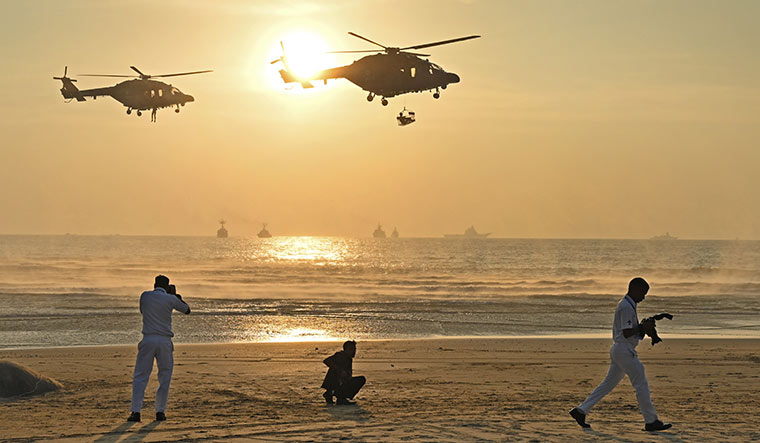 Indian Navy’s advance light helicopters in action during the Navy Day rehearsals at Tarkarli beach in Maharashtra | Amey Mansabdar
Indian Navy’s advance light helicopters in action during the Navy Day rehearsals at Tarkarli beach in Maharashtra | Amey Mansabdar
Underwater domain awareness (UDA) is engaging the attention of many advanced countries, including India, for a variety of reasons. There is a need to know what is happening underwater. Several countries around the world and in the Indian Ocean Region either possess or are in the process of acquiring submarines. Underwater drones are being used for oceanographic research and development, mapping underwater contours, and monitoring submarine cables and other forms of scientific research. Use of autonomous underwater vehicles will see a rapid increase in the years ahead including their use for intelligence-gathering, clandestine attacks and covert operations. Monitoring of choke points and likely submarine operating areas with seabed arrays and other sensors will also increase. Technology development for such purposes will be a significant enabler for successfully exploiting the oceans.
UDA is not enough. India needs to develop underwater domain capability (UDC). Seabed exploitation, oil and mineral prospecting, oceanographic research, security needs and every other endeavour in the underwater domain require cutting-edge technology, capable platforms and highly skilled people to undertake such tasks. Though expensive, these are ‘must have’ capabilities in the short-to-medium term, not just for our own sake, but also to ensure that we regain the space lost to China and other countries in our backyard. Foreign research ships and oil-prospecting ships doing work for countries in our maritime neighbourhood is a result of our incapability to offer these services. There is much distance to cover.
MARITIME FOCUS AND ORIENTATION
The government could consider re-organising multiple departments that deal with the maritime space and create a ministry of maritime affairs with departments dealing with each vertical such as fisheries, ocean research, ports, maritime education, shipping, offshore and pollution reversal. Many of these aspects would demand decentralised execution in accordance with standard protocols. The Coast Guard could either be taken over by the ministry of home affairs and the Navy be divested of coastal security functions. Alternatively, it could be shifted under the department of military affairs of the ministry of defence for closer cooperation and integration with the Navy. Should theaterisation of the armed forces happen, the Coast Guard should become a component of the Maritime Theatre Command.
Also Read
- 'Navy aims to be Aatma Nirbhar by 2047': Vice Admiral Rajesh Pendharkar at THE WEEK Maritime Conclave 2024
- 'Nothing builds character like the sea': Solo circumnavigator Commander Abhilash Tomy at THE WEEK Maritime Conclave 2024
- 'Aim is to position India as a Maritime Vishwaguru': Union Minister Sarbananda Sonowal at THE WEEK Maritime Conclave 2024
- Andaman and Nicobar Islands must become the Hawaii of India
- Why India needs a proactive coastal security mechanism
- How are India's overtures in the Indo-Pacific complemented
More than anything, India needs a blue re-orientation. The population in general must know more about the oceans. Maritime academies and departments should be formed in universities. There should be maritime tourism and water sports. Beaches and islands should be popularised as maritime adventure destinations, creating the necessary infrastructure and workforce for such endeavours. The seas must be de-mystified in the minds of the youth.
It would be wise to recall the words of Sardar K.M. Panikkar, one of India’s early maritime thinkers, who wrote in his seminal work, India and the Indian Ocean: An Essay on the Influence of Sea Power on Indian History (1945), “If India desires to be a naval power, it is not sufficient to create a navy however efficient and well-manned. It must create a naval tradition in the public, a sustained interest in oceanic problems, and a conviction that India’s future greatness lies on the sea.” India’s transition into the big league will be significantly enabled by translating Panikkar’s vision into reality.
The author is a former commander-in-chief of the Eastern Naval Command.


